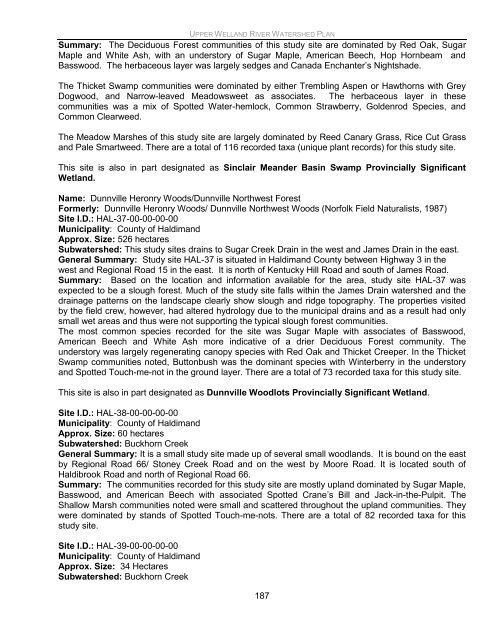Upper Welland River Watershed Plan - Niagara Peninsula ...
Upper Welland River Watershed Plan - Niagara Peninsula ...
Upper Welland River Watershed Plan - Niagara Peninsula ...
You also want an ePaper? Increase the reach of your titles
YUMPU automatically turns print PDFs into web optimized ePapers that Google loves.
UPPER WELLAND RIVER WATERSHED PLANSummary: The Deciduous Forest communities of this study site are dominated by Red Oak, SugarMaple and White Ash, with an understory of Sugar Maple, American Beech, Hop Hornbeam andBasswood. The herbaceous layer was largely sedges and Canada Enchanter‟s Nightshade.The Thicket Swamp communities were dominated by either Trembling Aspen or Hawthorns with GreyDogwood, and Narrow-leaved Meadowsweet as associates. The herbaceous layer in thesecommunities was a mix of Spotted Water-hemlock, Common Strawberry, Goldenrod Species, andCommon Clearweed.The Meadow Marshes of this study site are largely dominated by Reed Canary Grass, Rice Cut Grassand Pale Smartweed. There are a total of 116 recorded taxa (unique plant records) for this study site.This site is also in part designated as Sinclair Meander Basin Swamp Provincially SignificantWetland.Name: Dunnville Heronry Woods/Dunnville Northwest ForestFormerly: Dunnville Heronry Woods/ Dunnville Northwest Woods (Norfolk Field Naturalists, 1987)Site I.D.: HAL-37-00-00-00-00Municipality: County of HaldimandApprox. Size: 526 hectaresSubwatershed: This study sites drains to Sugar Creek Drain in the west and James Drain in the east.General Summary: Study site HAL-37 is situated in Haldimand County between Highway 3 in thewest and Regional Road 15 in the east. It is north of Kentucky Hill Road and south of James Road.Summary: Based on the location and information available for the area, study site HAL-37 wasexpected to be a slough forest. Much of the study site falls within the James Drain watershed and thedrainage patterns on the landscape clearly show slough and ridge topography. The properties visitedby the field crew, however, had altered hydrology due to the municipal drains and as a result had onlysmall wet areas and thus were not supporting the typical slough forest communities.The most common species recorded for the site was Sugar Maple with associates of Basswood,American Beech and White Ash more indicative of a drier Deciduous Forest community. Theunderstory was largely regenerating canopy species with Red Oak and Thicket Creeper. In the ThicketSwamp communities noted, Buttonbush was the dominant species with Winterberry in the understoryand Spotted Touch-me-not in the ground layer. There are a total of 73 recorded taxa for this study site.This site is also in part designated as Dunnville Woodlots Provincially Significant Wetland.Site I.D.: HAL-38-00-00-00-00Municipality: County of HaldimandApprox. Size: 60 hectaresSubwatershed: Buckhorn CreekGeneral Summary: It is a small study site made up of several small woodlands. It is bound on the eastby Regional Road 66/ Stoney Creek Road and on the west by Moore Road. It is located south ofHaldibrook Road and north of Regional Road 66.Summary: The communities recorded for this study site are mostly upland dominated by Sugar Maple,Basswood, and American Beech with associated Spotted Crane‟s Bill and Jack-in-the-Pulpit. TheShallow Marsh communities noted were small and scattered throughout the upland communities. Theywere dominated by stands of Spotted Touch-me-nots. There are a total of 82 recorded taxa for thisstudy site.Site I.D.: HAL-39-00-00-00-00Municipality: County of HaldimandApprox. Size: 34 HectaresSubwatershed: Buckhorn Creek187
















